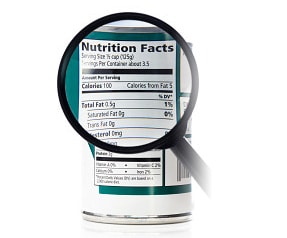
Medically Reviewed
March 5, 2014
There are few things that make a Nutrition expert happier than when consumers are properly informed about what they are eating and serving to their families, but many people are asking what are these proposed food label changes that are soon to happen?
It brings me hope to see, after 20 years, the FDA is open to making some major changes to nutrition labels.
The proposed updates by the U.S. Food and Drug Administration would impact serving sizes and calories. The updated labels would also list added sugars.
“The goal is to make people aware of what they are eating and give them the tools to make healthy dietary choices throughout the day,” says Jessica Leighton, Ph.D., senior nutrition science and policy advisor in FDA‘s Office of Foods and Veterinary Medicine,
It has taken years for nutrition professionals to teach the public to read labels on their food. Most of us now look for the nutrition content and label. Great progress, right?
Currently, labels on foods and beverages are way too confusing for consumers.
Featuring a thin woman on the label, jumping in a pasture while eating chocolate may lead some to think the product is healthy or natural. Flip this package over to view the nutrition label and you could be led even further from the truth.
The serving sizes listed on the label seem openly misleading.
Most of us simply do not pull out our measuring cup and tablespoon when diving into a product. If the portion sizes on the labels were closer to what a normal consumer eats, you might see 3x what is listed as the serving size.
A seemingly benign food takes on an entirely different meaning when the calorie count is proportional to the serving size.
Changing the information regarding serving sizes is a huge step.
What these new guidelines might help us all do is to standardize measurements, and help us evaluate the truth.
The proposed changes are about three years away from implementation.
What to do until then? At Nava Health & Vitality Center, we teach our clients how to incorporate real, whole foods into their diets. We advocate avoiding heavily processed and unnatural foods as much as possible. If you stick with eating foods as close to their natural state as possible, you avoid label confusion. An apple does not require a nutrition label.
Another tip would be to start measuring some of your food.
So many of us assume we know what ½ a cup looks like, or even a tablespoon, but the reality is that we often dole out much larger portions.
Taking the time to measure out portion sizes of various packaged foods can be real eye-opener. I am not suggesting that you cart around a food scale wherever you go. Just take the time at home to train your eye on what a serving size really looks like.
Ultimately, the FDA proposed changes are a fantastic step in the right direction.
I think consumers will be in for a real shock when the more accurate servings are listed on the labels. These proposed changes are a great first step, but there is still more work to be done.
Eat well, be well my friends! Then contact Nava.

A Medical Director, and one of the first physicians to join the Nava Health & Vitality Center, Dr. Douglas Lord has made significant contributions to our Center and its founding principles. Dr. Lord has helped develop and implement the Nava Method™—Nava’s proprietary approach to total body wellness. He has also been instrumental in liaising with other expert practitioners to successfully implement Nava’s range of therapies, treatments, and products.